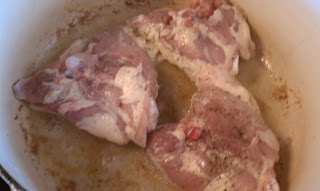The filling of this stuffed pasta is a little sweet from the browned onions, the honey and the squash itself and the sauce is super savory consisting of nothing more than butter and fresh sage. The filling was inspired by
this recipe from
this book.
The pasta dough was all
@ruhlman.

Home made pasta dough is easy and fun to do
Squash Ravioli
For the pasta;
9 ounces flour
3 eggs
For the filling;
1 cabocha (or whatever winter squash you like) pumpkin, halved and seeded
2 egg yolks
1 tablespoon olive oil
1 onion, finely chopped
1 teaspoon red pepper flakes
1 teaspoon cinnamon
2 tablespoons grated parmigiano-reggiano
2 teaspoons honey
1 cup stock or white wine
salt to taste
grated parmigiano-reggiano for serving
For the sauce;
6 tablespoons butter
18 fresh sage leaves chopped (this is Saveur's ratio but you can use more or less of either)
Pasta.
Mound the flour on the counter or table and make an indentation for the eggs. Crack in the eggs and begin working the flour into the eggs and breaking up the eggs with your fingers. Eventually you will have a cohesive mass to begin kneading by pressing the dough firmly with your palm, folding the dough in half and repeating . Ruhlman's directions are to do this until it has a silky texture, 5 - 10 minutes. I am not sure what is a silky texture. I split the difference and knead for 8 minutes. Press the dough into a disc. Cover it with plastic wrap and let rest for 15 minutes to an hour. The dough can be refrigerated for up to 24 hours.
Filling.
Preaheat oven to 375°F. Bake the squash cut side down on a baking sheet covered in foil until tender. Mine took about 45 minutes but I gave it an hour so it was downright soft. Remove and cool to a handleable temperature. Remove the skin. Add pulp to a bowl and mash. Beat in the egg yolks and set aside.
Heat olive oil in a large skillet over medium heat. Add onions and cook until soft (10 minutes). Add red pepper flakes, cinnamon, cheese, honey, stock and salt and cook for 3 - 4 minutes. Mix in the squash-egg mixture, cook for 2 minutes. Remove from heat and cover to keep warm.
Ravioli.
Cleave pasta disc into 4 quadrants. roll each as thinly as possible.
This is facilitated with a pasta roller but I have used a rolling pin. It works.
Put generous tablespoons of filling a couple of inches apart on one piece of dough.
Moisten the dough around the filling with a finger dipped in water. Place another piece of dough atop this one and press around the filling to seal. Cut into squares.
I used a pizza cutter. I also managed to pour my finger dipping water onto the first batch necessitating some fast action and a bit more flour to render them usable.
Sauce.
Heat butter in a small pan over medium heat. Add sage and cook until golden brown.
Putting it all together.
Boil the ravioli in lots of salted water for about 3 minutes. Drain, plate and drizzle with sage butter and sprinkle with cheese.
Shrimp13













































